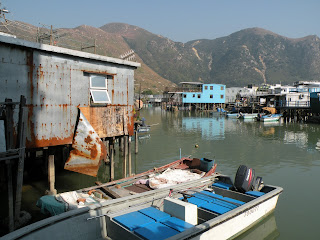of this five-day trip to explore Hong Kong I feel I want to start from the end. From the village of Tai O on the southwest coast of the island of Lantau (to understand that where there are - in the far east - even the airport in Hong Kong and Disneyland) that the Hong Kong designer shopping malls, skyscrapers and futuristic views grandiose breathtaking does not really nothing to see. And this is what the bottom really fascinated me, beyond the fact that they had had the place nor the time nor the opportunity nor the way to get an idea Before you set foot. We arrive by taxi, after checking in at the train station, after reaching the airport on the train modern Jet-express and taking a local taxi blue, unlike red and green to the island of Hong Kong and Kowloon, is not outside waiting for us. We are having to wait for him. And this, I should have known at the time, could be the harbinger of a certain way of being the place that I discovered shortly thereafter. the place - Tai O - I knew nothing except the bare and neutral description read in the guide. The change that we encounter along the way we perceive it, during those 40 minutes by taxi from the flat landscape cut straight roads with multiple lanes and huge housing complexes leads us gradually into a winding up and down among the green hills behind which to Whether you can see the sea, sometimes a bay, at times a barren slope, even for a moment the giant Buddha sitting on top of the hill that rises to Ngong Ping . The machine shoots, the body is a bit 'stretched to anticipate or counter the light bounced back seat. But the eye and captures the lightning three-dimensionality of this landscape is well preserved, a little disturbed by man. Filiamo away quickly leaving behind all the reasons known and glamorous that attract tourists to Hong Kong.
Walking along the narrow streets of the village, surrounded by these timeless buildings glinting in the sun and hardly recall to a type of house known for our times, rummage through the interior of the stilts clean and decent, I am happy to pick up the signals and sounds of a joyful life and strives to invent around the sea, its products, its challenges. The few square meters of these shelters are an example of efficiency, wise and clever use of space, creativity and imagination of practice have been forgotten by most. Everything revolves around the activities of fishing, being and fish processing, preparation of shrimp paste. The smell is topic, sometimes almost sickening to modern so cleaned up our noses.












0 comments:
Post a Comment